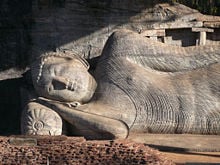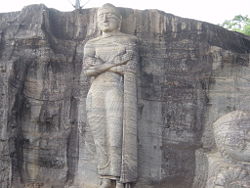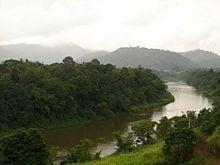Difference between revisions of "Polonnaruwa" - New World Encyclopedia
Dan Davies (talk | contribs) |
Dan Davies (talk | contribs) |
||
| Line 145: | Line 145: | ||
===Other Archeological ruins in the Polonnaruwa District=== | ===Other Archeological ruins in the Polonnaruwa District=== | ||
| − | * [[Dimbulagala]] | + | * [[Dimbulagala Raja Maha Vihara|Dimbulagala]] |
| − | * | + | * Madirigiriya |
| − | * | + | * Namal Pokuna |
| − | * | + | * Silumina Saya |
| − | * | + | * Maduru Oya |
| − | * | + | * Thoppigala |
| − | * | + | * Kalahagala |
| − | * | + | * Alahara |
| − | * | + | * Girithale |
==Polonnaruwa in the Twenty First Century== | ==Polonnaruwa in the Twenty First Century== | ||
Revision as of 21:00, 24 August 2008
| Ancient City of Polonnaruwa* | |
|---|---|
| UNESCO World Heritage Site | |

| |
| State Party | |
| Type | Cultural |
| Criteria | i, iii, vi |
| Reference | 201 |
| Region** | Asia-Pacific |
| Inscription history | |
| Inscription | 1982 (6th Session) |
| * Name as inscribed on World Heritage List. ** Region as classified by UNESCO. | |
UNESCO designated the ancient city of Polonnaruwa a World Heritage site.
King Vijayabahu I declared Polonnaruwa, the second most ancient of Sri Lanka's kingdoms, the capital city in 1070 C.E. He defeated the Chola invaders to reunite the country once more under a local leader. While historians consider Vijayabahu's victory, and the shifting of Kingdoms to the more strategic Polonnaruwa, significant, his grandson, Parakramabahu I receives much credit for building Polonnaruwa. During Chola's short reign, Polonnaruwa had been called Jananathamangalam.[1]
Golden Age of Polonnaruwa
| Polonnaruwa | |
| Statue at Gal Vihariya | |
| Coordinates: {{#invoke:Coordinates|coord}}{{#coordinates:7|56|0|N|81|0|0|E|type:city | |
|---|---|
| name= }} | |
| Country | Sri Lanka |
| Province | North Central Province, Sri Lanka |
| Polonnaruwa | Before 1070 C.E. |
| Government | |
| - Mayor | |
| Area | |
| - Total | 3,293 km² (1,271.4 sq mi) |
| - Land | 3,077 km² (1,188 sq mi) |
| - Water | 216 km² (83.4 sq mi) |
| Population (2001) | |
| - Total | 359,000 |
| - Density | 117/km² (303/sq mi) |
| Time zone | Sri Lanka Standard Time Zone (UTC+5:30) |
Parakramabahu I's reign marked the Golden Age of Polonnaruwa, when trade and agriculture flourished under his patronage. The king directed that rain water would be used to irrigate crops, directing the creation of irrigation systems superior to those of the Anuradhapura Age. Those irrigation systems still supply the water for paddy cultivation during the dry season in the eastern part of the country. The largest of those systems, the Parakrama Samudraya or the Sea of Parakrama, constitutes a tank that people often mistaken for a sea. The tank has a width such that a person standing on one shore can not view the other side. It encircles the main city, serving as both a defensive border against intruders and the main source of water during peace time. The Kingdom of Polonnaruwa enjoyed complete water self-sufficiency during King Parakramabahu's reign.[2]
With the exception of his immediate successor, Nissankamalla I, the other monarchs of Polonnaruwa had been less effective leaders, suffering from dissension within their courts. They formed matrimonial alliances with the stronger South Indian Kingdoms, those matrimonial links superseded the local royal lineage. That gave rise to King Kalinga Magha's invasion in 1214. That invasion set the stage for a Pandyan King to take the throne following the Arya Chakrawarthi invasion of Sri Lanka in 1284, the capital shifting to Dambadeniya.[3]
Polonnaruwa Kingdom
The Polonnaruwa Kingdom reigned from eighth century until 1310 C.E. After ruling the country for over 1200 years as the Anuradhapura Kingdom, Sri Lankan kings decide to move their capital to Polonnaruwa, hoping that the distance further inland from Anuradhapura would allow more time to organize defenses in times of foreign invasion. Polonnaruwa had previously been an important settlement in the country as it commanded the crossings of the Mahaweli Ganga towards Anuradhapura.
Two of the rulers of Polonnaruwa include Vijayabahu I and Parakramabahu I (Parakramabahu the Great). Most of the remains of Polonnaruwa date from after the 1150s, as the extensive civil wars that preceded Parakramabahu's accession to the throne devastated the city. The Polonnaruwa Kingdom had been abandoned in the fourteenth century, and the seat of government for the Sinhalese kings moved to Yapahuwa. Although many factors contributed to that, south India's ability to launch invasions upon the city had been the leading cause for the abandonment of Polonnaruwa as the capital city of Sri Lanka.
Kings and Queens of Polonnaruwa
- Vijayabahu I
- Jaya Bahu
- Vikrama Bahu
- Parakrama Bahu, The Great
- Nissankamalla I
- Queen Lilavati
Polonnaruwa Archaeological Site
Gal Vihare

The Gal Vihare refers to a rock temple of the Buddha in Polonnaruwa. Parākramabāhu I constructed the temple in the twelfth century, his architects excavating the shrine and leaving an inscription describing their work.[4] Four large statues of the Buddha, carved into the face of a granite boulder by Parakramabahu's architects, constitute the central attraction of the shrine. Those include a recumbent statue of the Buddha measuring forty six feet and a standing statue twenty three feet in height.[5]
Historians have identified a standing figure on a lotus throne located in the shrine Parākramabāhu I as Ananda, the Buddha's chief disciple, weeping over the recumbent figure of the Buddha who has just attained Nirvana.[4] Some historians, including Dr. Andreas Nell suggest that the expression of sorrow on the Buddha's had been created by the natural elements ware upon the stone.[4]
Other Archeological ruins in the Polonnaruwa District
- Dimbulagala
- Madirigiriya
- Namal Pokuna
- Silumina Saya
- Maduru Oya
- Thoppigala
- Kalahagala
- Alahara
- Girithale
Polonnaruwa in the Twenty First Century
The remains of the ancient city of Polonnaruwa stands as the best planned archaeological relic sites in the country, bearing testimony to the discipline and greatness of the kingdom's first rulers. Nearby the ancient city, a small town offers several hotels and several shops for daily necessities. Government institutions stand in a newly built area called “New Town,” about six kilometers away from the town on the main road. The largest school in the district, Polonnaruwa Royal Central College operates in New Town.
Polonnaruwa constitutes the second largest city in North Central Province, considered one of the cleaner and more beautiful cities in the country. The green environment, amazing ancient constructions, Parackrama Samudraya (a huge lake built in 1200 C.E.), quality tourist hotels and friendly local peoples attracts visitors from near and far. Historically Polonnaruwa has had a tropical climate most of the year, although occasionally experiencing chilly weather in December and January. Recently an increase in rain fall and lower temperatures have been measured. Visitors to Polonnaruwa tend to appreciate the cooler weather although paddy field farmers suffer when their fields experience flooding.[6]
Gallery
See also
- Anuradhapura
- Sigiriya
- Mahawamsa
Notes
- ↑ World and its peoples: Eastern and southern Asia. 2007. (New York: Marshall Cavendish), p. 351
- ↑ Walter Nubin. 2002. Sri Lanka: current issues and historical background (New York: Nova Science Publishers), p. 103.
- ↑ John Faithful Fleet. 1882. The dynasties of the Kanarese districts of the Bombay presidency from the earliest historical times to the Muhammadan conquest of A.D. 1318. [Ames Library pamphlet collection, 97:6]. (Bombay: Government Central Press), p. 59.
- ↑ 4.0 4.1 4.2 Jones-Bateman, R (1932). An illustrated guide to the buried cities of Ceylon. Kandy: Queen's Hotel, Kandy. OCLC 363716.
- ↑ The Medieval Capital of Polonnaruwa. Sri Lanka Ministry of Tourism. Retrieved 2008-08-04.
- ↑ Richard Plunkett, Brigitte Ellemor, and Verity Campbell. 2003. Sri Lanka (Melbourne, Vic: Lonely Planet), p. 234f.
ReferencesISBN links support NWE through referral fees
- Abeysinghe, Abeyratna Banda. 1998. Guide to Polonnaruwa. Panadura: Dimuthu Printers. ISBN 9789558096000.
- Balasooriya, Jayasinghe (2004). The Glory of Ancient Polonnaruva. Sooriya Printers, Polonnaruva. ISBN 955-8158-01-1 (Archeological ruins)
- Basnayake, H. T., and Uda Hettige. 2007. Polonnaruwa civilization. Colombo: Godage International Book Publishers. ISBN 9789552074752.
- Fleet, John Faithful. 1882. The dynasties of the Kanarese districts of the Bombay presidency from the earliest historical times to the Muhammadan conquest of A.D. 1318. [Ames Library pamphlet collection, 97:6]. Bombay: Government Central Press. OCLC 30609559.
- Nubin, Walter. 2002. Sri Lanka: current issues and historical background. New York: Nova Science Publishers. ISBN 9781590335734.
- Paranavitana, Senarat and Cyril Wace Nicholas. 1961. A Concise History of Ceylon. Ceylon University Press, Colombo. OCLC 465385.
- Plunkett, Richard, Brigitte Ellemor, and Verity Campbell. 2003. Sri Lanka. Melbourne, Vic: Lonely Planet. ISBN 9781740594233.
- World and its peoples: Eastern and southern Asia. 2007. New York: Marshall Cavendish. ISBN 9780761476351.
External links
- Detailed map of Polonnaruwa and Sri Lanka. Retrieved August 4, 2008.
- Discover Sri Lanka - More information & images about Polonnaruwa. Retrieved August 4, 2008.
- Discover Sri Lanka - Historical background of Polonnaruwa. Retrieved August 4, 2008.
- Discover Sri Lanka - Old City of Polonnaruwa. Retrieved August 4, 2008.
- The Medieval Capital of Polonnaruwa. Retrieved August 4, 2008.
- Polonnaruwa. Retrieved August 4, 2008.
- Ancient City of Polonnaruwa. Retrieved August 4, 2008.
- Polonnaruwa Ancient City, Sri Lanka. Retrieved August 4, 2008.
- Ancient City of Polonnaruwa - World Heritage. Retrieved August 4, 2008.
- "Discovering Polonnaruwa" - an article in The Hindu. Retrieved August 4, 2008.
- Galvihara - a unique display of rock art. Retrieved August 4, 2008.
- Official website of the Sri Lanka Tourism Board. Retrieved August 4, 2008.
- A list of traditional names of cities in Sri Lanka. Retrieved August 4, 2008.
- Places of interest in polonnaruwa. Retrieved August 4, 2008.
| ||||||||||
| |||||||
Template:Buddhism2
Credits
New World Encyclopedia writers and editors rewrote and completed the Wikipedia article in accordance with New World Encyclopedia standards. This article abides by terms of the Creative Commons CC-by-sa 3.0 License (CC-by-sa), which may be used and disseminated with proper attribution. Credit is due under the terms of this license that can reference both the New World Encyclopedia contributors and the selfless volunteer contributors of the Wikimedia Foundation. To cite this article click here for a list of acceptable citing formats.The history of earlier contributions by wikipedians is accessible to researchers here:
The history of this article since it was imported to New World Encyclopedia:
Note: Some restrictions may apply to use of individual images which are separately licensed.







